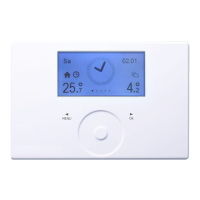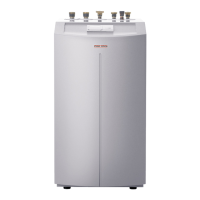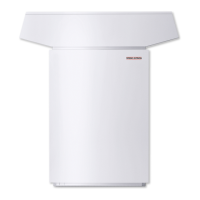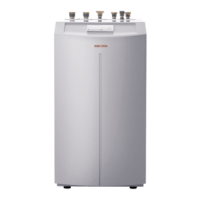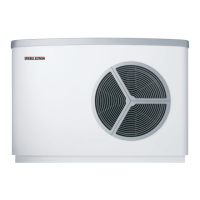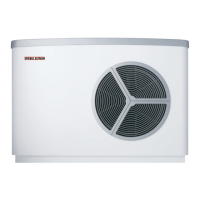vent relay is switched OFF during defrosting,
and the defrost relay is started without delay.
The type of defrosting influences the buffer
loading pumps. In case of hot gas defrosting,
the buffer loading pumps are switched OFF,
whilst during reverse defrosting, the buffer
loading pumps remain switched ON.
During reverse defrosting the evaporator
temperature is also monitored. If, during de-
frosting, this temperature falls below 10 °C for
at least 15 s, then the heat pump is switched
OFF and the idle time is set. The display indi-
cates a lack of frost protection with a flashing
triangle.
HP type 2 activates an additional evaporator
temperature monitor during defrosting.
As soon as the evaporator temperature falls
below 15 °C, HS 2 is started (DHC insert),
independent of the dual mode point, to pro-
vide heating. HS 2 is switched OFF as soon as
defrosting has terminated, and the heat pump
continues its heating operation.
However, if 10 °C is reached during the
defrost process (heat pump plus HS 2 opera-
ting), the heat pump is switched OFF, and HS
2 alone remains ON and regulates to the set
return temperature.
With HP type 2 and 3, heating circuit pump 1
for the direct heating circuit is also switched
OFF during the defrost phase.
Defrost operation without buffer cylinder
From software version IWS 1907 and WPMII
6504, a new function sequence applies to sys-
tems without buffer cylinder. The new function
will only be enabled if the parameter constant
buffer primary pump operation has been set
to ON.
The heat pump enters its heating mode and
defrosting commences.
Previously, defrosting was initiated via a baro-
metric cell, and the defrost input was initiali-
sed directly at the IWS. This no longer applies.
After the barometric cell has responded, and
until defrosting has been initialised by the IWS,
the temperature differential between the ISW
(condenser temperature) and the heating
return must be <= 25K. The machine will be
shut down with the error message „Defrost“,
if the differential is greater than 25K. The heat
pump restarts again after defrosting in stan-
dard heating or DHW mode. Error logic - 5
errors in 2 hours operation (NEW, previously
the time limit was 5 hours) create a fatal error,
this logic is retained.
Heat pump in DHW mode and defrosting
will be initiated.
After the pressure transducer has responded,
the equipment will be operated in heating
mode for five minutes; forced heating flow and
return sensors will then be masked. Defrosting
will be initiated if, after expiry of that time, the
temperature differential between the IWS and
the heating return is <= 25K. The machine
shuts down with a “defrost fault“, if the diffe-
rential is greater than 25 K. The machine then
re-enters the DHW mode.
Maximum defrost time
Maximum defrost time differentiates between
hot gas and reverse defrosting. It is determi-
ned by the position of the slide switches (WP-
Typ) on the IWS.
For HP type 1, the maximum defrost time
for hot gas defrosting is 25 minutes, and for
reverse defrosting 7 minutes.
For HP type 2 and 3, only reverse defrosting
is possible; for this defrosting lasts a maximum
of 20 minutes. Defrosting is terminated for all
heat pump types after the maximum defrost
time has expired. In that case, heat pumps are
forced to operate in heating operation for 20
minutes. Only then can a new defrost process
be initiated.
40
CNTRL RESP TM
Setting range 0 to 30
The selected control response time is a
measure of the switching gap between the
individual compressor stages.
The selected control response time is a
measure of the switching gap between the
individual compressors and the internal HS 2.
Normally, the selected response time should
operate sufficiently fast and vibration free.
Heating systems which respond quickly re-
quire a lower value, whilst very slow reacting
systems require you to set a higher value.
41
COMP IDLE TIME
After a heat pump has been switched OFF, an
idle time is set as protection for the compres-
sor. The default idle time of 20 minutes should
normally not be reduced. Where a reduction
is required because of adjustments or repair
work, reset the idle time again to 20 minutes
after completing the necessary work.
42
COMP DLAY CNTR
Residual idle time
Pressing PRG enables you to scan the idle
times of the individual compressors.
43
QUICK START
During commissioning, you can test the heat
pump function by triggering a quick start
for all heat pumps. When this parameter is
started, OFF appears at the bottom of the
display. Pressing PRG initiates a quick start. The
respective pumps are started after the heat
pump start. The value 60 is visibly counted
down to 0 on the display; then the display
shows ON.
After that, compressor 1 and the associated
buffer loading pump are switched ON. All
compressors are then started in 10 s intervals.
You exit this function by pressing PRG or by
closing the control flap. OFF is displayed again.
44
RELAY TEST
Pressing PRG and continuing to turn the ro-
tary selector allows you to individually call up
the WPM II relay outputs. The individual out-
puts are displayed as plain text.
45
LCD TEST
Pressing PRG once initiates a LCD test. All dis-
play elements are displayed in sequence.
46
ERROR LIST
Pressing PRG displays
fault code 1. The fault is described in plain text
at the top of the display, the bottom shows
the fault number. Continuing to turn the ro-
tary selector still displays fault 1. As additional
information, the display shows the day, month
and year together with the relevant time,
when the fault occurred. At the bottom of the
display, arrows indicate the HP number. Arrow
1 means HP 1, arrow 2 means HP 2, etc.
In total, 20 faults can be displayed. You can
reset the error list via a hardware reset.

